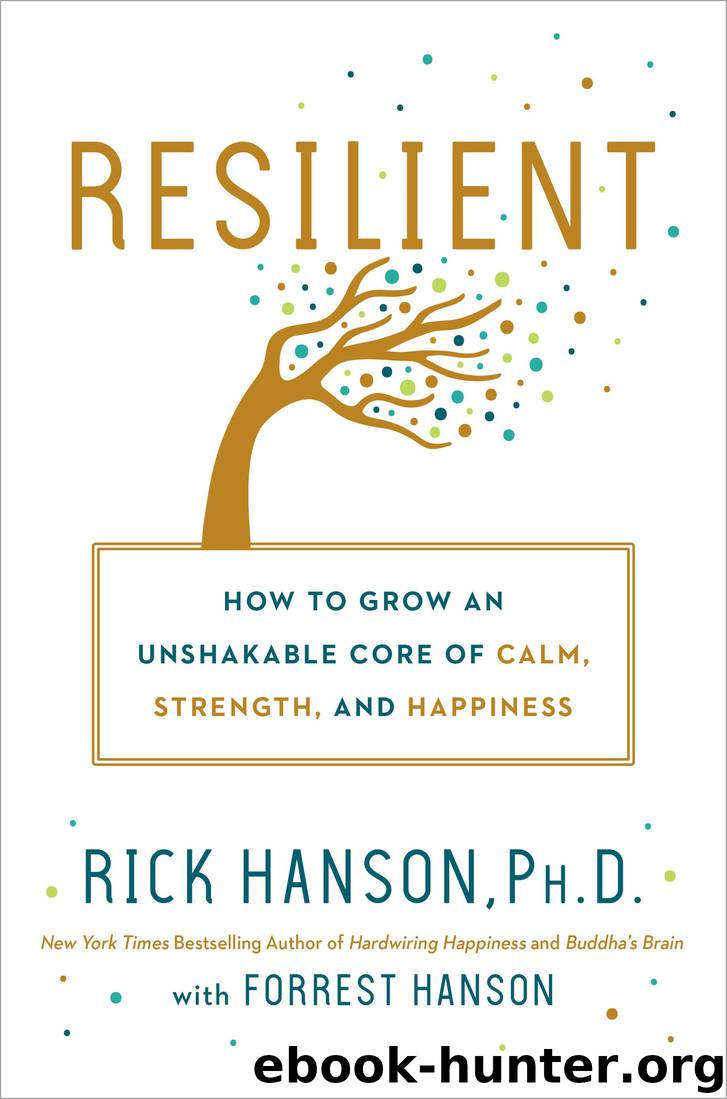Resilient by Rick Hanson Ph.D. & Forrest Hanson

Author:Rick Hanson, Ph.D. & Forrest Hanson
Language: eng
Format: epub
Publisher: Potter/TenSpeed/Harmony
Published: 2018-03-27T04:00:00+00:00
RELAXING AND CENTERING
As Alan Watts said, life is “wiggly.” Inside the body and mind, things are continually changing, for better or worse. Plus we live in an increasingly volatile, uncertain, complex, and ambiguous world whose ripples surge through us each day.
The Healthy Resting State
To keep you on an even keel as you ride the inner and outer waves, the autonomic nervous system manages your body and mind through its parasympathetic and sympathetic branches. Think of these like the brake and gas pedals of a car. The “rest-and-digest” parasympathetic nervous system evolved first, before the sympathetic nervous system developed. When it is engaged, the heart rate slows down and the body refuels and repairs itself. Extreme parasympathetic activation can produce an intense freeze response, such as feeling like you can’t speak, the human equivalent of an animal “playing dead.” But normal parasympathetic activity feels good, with a sense of relaxed, centered well-being.
On the other hand, the sympathetic nervous system puts the pedal to the metal, mobilizing the body for action by speeding up the heart while hormones such as adrenaline and cortisol course through the blood. As the body revs up, so does the mind, with more intense thoughts and feelings. As we’ll see in the next chapter, sympathetic activation is a wonderful source of passion and resilience when it’s combined with positive emotions such as happiness, love, and confidence. The healthy resting state of your body and mind involves substantial parasympathetic activity with just enough sympathetic activation to keep things interesting. But when the sympathetic nervous system is combined with negative emotions such as anger or fear, these fight-or-flight reactions are stressful and upsetting. They burden your body and mind, and strain your relationships.
Unfortunately, our modern, go-go-go culture routinely pushes people into sympathetic nervous system overdrive with few opportunities for sustained parasympathetic recovery. There can also be individual reasons for sympathetic activation, such as having a driven personality or being on edge as a result of past trauma. Many of us experience chronic mild to moderate stress, living much of the time in a kind of “pink zone.”
A person could slow down and do less. But the realities of work and family usually make this hard to achieve. If you are going to stay busy while juggling many balls and plates, it helps to keep engaging the parasympathetic wing of the nervous system along the way. One of the best ways to do this is through frequent practices of relaxation.
Download
This site does not store any files on its server. We only index and link to content provided by other sites. Please contact the content providers to delete copyright contents if any and email us, we'll remove relevant links or contents immediately.
The Four Agreements by Don Miguel Ruiz(6313)
Flow by Mihaly Csikszentmihalyi(4488)
The Four Tendencies by Gretchen Rubin(4423)
You Do You by Sarah Knight(4326)
Adulting by Kelly Williams Brown(4232)
The Hacking of the American Mind by Robert H. Lustig(4082)
A Simplified Life by Emily Ley(3965)
Right Here, Right Now by Georgia Beers(3913)
Ikigai by Héctor García & Francesc Miralles(3889)
The Power of Positive Thinking by Norman Vincent Peale(3858)
The Art of Happiness by The Dalai Lama(3844)
The Little Book of Hygge by Meik Wiking(3443)
The French Women Don't Get Fat Cookbook by Mireille Guiliano(3410)
The Heroin Diaries by Nikki Sixx(3317)
Why Buddhism is True by Robert Wright(3280)
The Courage to Be Disliked by Ichiro Kishimi & Fumitake Koga(3253)
The Choice by Edith Eva Eger(3211)
Spark Joy by Marie Kondo(3087)
Make Your Bed by William H. Mcraven(2987)
